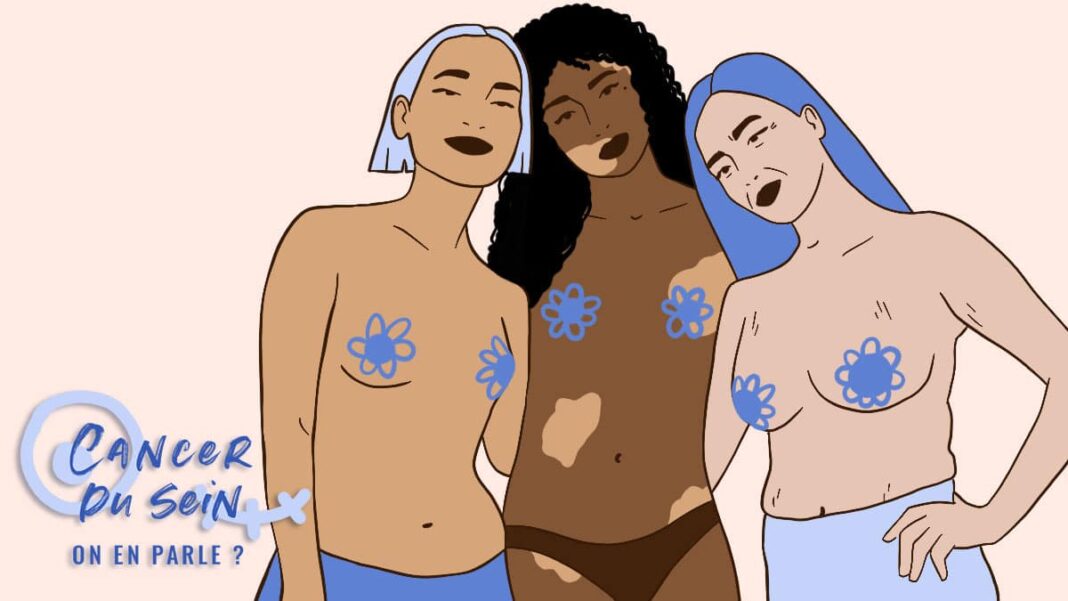Article published on October 8, 2019
In France, 1 in 8 women will develop a breast cancer during his lifetime, according to The League Against Cancer. If handled in time, this cancer can be cured in 9 out of 10 cases. Hence the importance of awareness and early diagnosis of anomalies. But despite numerous campaigns, misconceptions and prejudices about this type of cancer (and its treatments) die hard.
Dr Nasrine Callet, gynecologist-oncologist at the Institut Curie de Saint-Cloud, answered our questions to unravel the true and the false about breast cancer. Because you know what they say: “Be warned is avambrato”.
1. “Breast cancer is a women’s story”
Breast cancer is often considered a female disease. And not without reason! It is the most common cancer in women, with approximately 53,000 new cases detected each year.
However, 1% of breast cancers occur in men.
The symptoms are the same for both sexes, but it is true that the abnormalities are often easier to detect in men, both by sight and by touch, because their breasts are generally less voluminous than those of women, points out the gynecologist.
2. “Breast cancer only affects the elderly”
In the collective imagination, breast cancer is a disease that only affects women in old age. It’s not wrong, but it’s not quite true either.
In the general population, the age of onset of breast cancer is around 63, explains Dr. Callet. This is why mammography and ultrasound screening is offered to women over the age of 50.
However, around 3,000 breast cancers are diagnosed in women under 40 each year. That is why whatever your age, you have to keep in mind that it can happen at any time, and even more so if you have already had cases in the family.

3. “There has never been breast cancer in my family, so I’m safe.”
Breast cancer is a multifactorial disease and several risk factors have been identified by health authorities over the years.
The genetic predisposition is the first of these cofactors and the Institut Curie estimates that around 120,000 women are predisposed to breast cancer in France (5% to 10% of breast cancers are of genetic origin according to the High Health Authority).
To date, two breast cancer predisposition genes have been identified, called BRCA1 and BRCA2, explains the gynecologist. They can be passed down from both parents and greatly increase the risk of one day developing breast or ovarian cancer.
The most difficult thing is to identify these patients with the mutation. Sure, a large number of breast cancer cases in the family can suggest hereditary cancer, but that’s not always the case. Likewise, it is not because no one in the family has yet been affected that you are not a carrier of the mutation, which could have been passed on from your father, for example.
Other cofactors such as pollution, tobacco, alcohol or even overweight have also been observed.
Birth control pills and breast cancer
For many years, the birth control pill, combination or micro-progestogen, has been accused of increasing the risk of breast cancer. Several studies in this direction have been published on the subject but the discussion remains open due to the lack of real medical consensus.
What we are sure of today, remembers Dr. Callet, is that women who take the pill very early or very late, at the time of periuberty or perimenosis, periods of severe hormonal imbalance, have a higher risk of developing cancer. breast. And this is even more true if they have a genetic predisposition.
4. “To cure breast cancer, you have to remove everything! “
The mastectomy, this surgical procedure which consists in the removal of the breast in its entirety, is very often associated with the treatment of breast cancer. However, this surgery affects “only” 40% of women and men diagnosed with this type of cancer.
Mastectomy should be avoided as much as possible, Dr. Callet insists, but sometimes it is necessary to remove sparse or advanced cancerous lesions. Sometimes we have to do this for technical reasons, without necessarily having any connection with the diagnosis.
However, as a precaution, we can sometimes offer a second breast mastectomy to a patient who has already had breast cancer and is affected by the genetic mutation that favors the onset of this type of disease. . It remains rare, but as these people have a higher risk of developing a second cancer, it is a solution that should sometimes be considered.
5. “Chemo is a mandatory step in curing breast cancer”
Although chemotherapy is often part of the treatments put in place to treat breast cancer, it is not not routinely recommended for all patients. Its usefulness is assessed based on the stage of the tumor at the time of diagnosis and the risk factors for recurrence.
The most classic treatment for breast cancer is to remove the tumor and then x-ray the rest of the breast to clean it up and prevent recurrence. Chemotherapy will be proposed or not depending on the nature of the tumor: if the lymph node is not affected and the tumor is not very active, it will not be done.
On the other hand, it may happen that it is proposed before surgery, to reduce the size of a tumor that is too large, in order to allow a conservative intervention. It really is case by case that it will depend on the patient’s type of breast cancer.
In fact, if we speak more commonly of “breast cancer”, there are several types.
Most breast cancers arise in the ducts or lobules, therefore we speak of ductal or lobular tumors in situ, but some infiltrate the surrounding breast tissue and can spread to the lymph nodes and then to other parts of the body, which are invasive tumors. explains the doctor.
Post-surgical treatment will depend on the diagnosis made and the specific characteristics of the tumor.
6. “From the age of 40, it is a mammogram every year”
The Bilateral mammography is the gold standard for breast lesions : it is the only one capable of detecting breast cancer at the very beginning of its formation. Mammography is systematically offered to women between the ages of 50 and 74 as part of an organized screening.
However, the usefulness and harmlessness of this test has been debated by the medical profession for several years due to the risks of overtreatment and false positives.
- To find out more about the dispute: the report of the Steering Committee for Citizen and Scientific Consultation launched in 2015 by the Minister of Health, Marisol Touraine, on organized screening for breast cancer.
For Dr. Callet, personalized screening should be preferred over organized screening.
It is not necessary to order mammograms every year for everyone. On the other hand, in women at risk, such as those who have cases of early stage breast cancer in the family, it is advisable to have one every year starting at a specified age which corresponds to the age of the youngest cancer onset in family.
Women with a genetic predisposition should also be monitored more regularly.
In 2017, Marisol Touraine announced that Social Security would cover 100% of a screening and prevention consultation for 25-year-old women. Nasrine Callet, who is very committed to breast cancer awareness, sees nothing but positive in it.
This consultation will help identify people at risk and monitor them more closely. I think this is how we will be able to effectively detect breast cancer, focusing on individualizing screening.
Photo credits on the cover: Klaus Nielsen
Source: Madmoizelle
Ashley Root is an author and celebrity journalist who writes for The Fashion Vibes. With a keen eye for all things celebrity, Ashley is always up-to-date on the latest gossip and trends in the world of entertainment.




